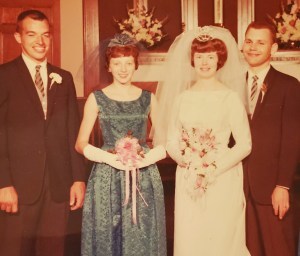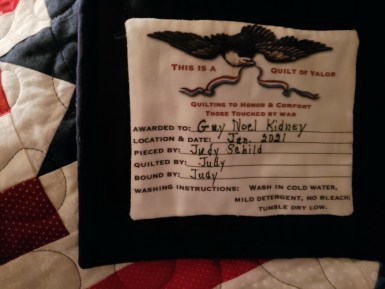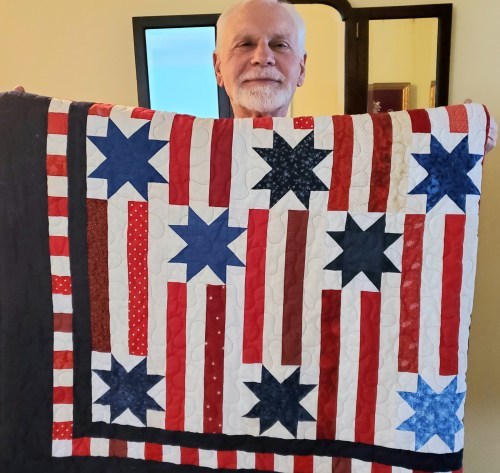Joy Neal Kidney's Blog, page 76
January 18, 2021
How I Became a History Fan (Not in School)
I was bored with history all the way through high school and college. So how did I become such a fan?
The U.S. Air Force sent my husband Guy to Mountain Home AFB, Idaho. I was invited to a “knitting” group which included civilian women of all ages as well as other military wives.
It was always called “knitting” but the gals did a variety of crafts and handwork, which I’d always enjoyed. The evening always included a dessert, provided by the hostess. When it was my turn to have the group, Guy would come home and open all the windows. Those were the days when smoking was commonplace.
One day one of the women announced that she’d gotten Civil War records about her great great grandfather. I had no idea that was even possible. How do you even start such a pursuit?
She sent me to the library to find a book called Know Your Ancestors. It took me step by step starting with writing my grandparents for everything they knew about their own parents and grandparents. Eventually I asked my grandmothers to write down the stories of their lives, which they both did. Such treasures!
Before long I was ordering copies of birth and death certificates and Civil War pension papers, which lead to reading biographies of Abraham Lincoln and histories of the Civil War.
Genealogy yielded real human beings, putting names and even faces on eras of American history, making it come alive for me.

After chasing names and dates as far back as I could, I began collecting cousins who wanted to know what I’d learned. Before our son was born in 1974, I typed up a couple of genealogies. I also transcribed my grandmothers’ memoirs and added photos to print and share.

My favorite generations to study have been the Mayflower (Guy and I have a total of five ancestors who came on the famous ship), and the whaling era of Nantucket Island.
Recent years have been devoted to fleshing out individuals on my family tree, especially those of my motherline, trying to imagine how Emilia came to Iowa from Ohio in a covered wagon as an 8-year-old, her first child (Laura) being born in the log cabin in Guthrie County three years after the end of the Civil War, her oldest daughter (Leora) riding a horse over dirt roads to piano lessons in Audubon, and attending sewing school in Exira in 1910, Laura learning to vote the first time in 1920 (Guthrie Center), Leora losing twins to whooping cough in 1929 (Dexter), Iowa waitress Doris becoming an officer’s wife in Texas during WWII, losing those three younger brothers.

But as I would study my ancestors, I’d also study what was going on in the world that they would have known about. That’s what finally made history interesting for me.
History is people!
January 15, 2021
Father Charles Coughlin–Union of Social Justice–1930s
After Clabe and Leora Wilson left tenant farming and moved to the town of Dexter, Iowa, he was sure he could find work with area farmers, enough to be able to take care of his family of seven children.
He was wrong. Even before the stock market crash of 1929, farmers were feeling the pinch of a depression in prices. Where to focus blame? Banks and railroads? They’d been supporters of William Jennings Bryan decades earlier, so had populist leanings.
In 1934 through 1936, they began to listen to a Detroit radio priest, Father Charles Couglin, who–in an Irish brogue–warned against money changers, “subversive socialism,” and said that international bankers had ruined America. Each week he lectured from his Shrine of the Little Flower in Royal Oaks, Michigan. “The New Deal in Christ’s Deal,” he declared, endorsing Roosevelt. He announced the formation of the National Union for Social Justice.

Father Coughlin didn’t want to oppose the president’s New Deal, he said. Just perfect it. He organized groups “To Keep America for America.” No politics, he stressed, just justice. Clabe and Leora were faithful listeners of this sermonizer from Royal Oak, Michigan.
In spite of having so little, they must have sent a small donation to the radio priest. Why else would there be a small crucifix and a Holy Ghost charm, souvenirs of the Shrine of the Little Flower, Royal Oak among their keepsakes decades later?

From Leora’s Dexter Stories: The Scarcity Years of the Great Depression, to be published late winter 2021.
January 13, 2021
Farm Boy (poem)
 (2005)
(2005)
January 12, 2021
Morrisburg Cemetery (poem) by Nicholas Dowd
Joy: I knew that my great grandmother, Georgia Williams Davis Wilson, was buried at Morrisburg. It felt lonely, since her husband Daniel Wilson is buried at Coon Rapids among the Wilsons.But recently a genealogist has been collecting information about Georgia Wilson’s descendants. He told me that there are at least thirty Williams relatives buried at Morrisburg. So Great Grandmother Georgia is among her family.I had just re-savored Nick’s poem about the cemetery so asked if I could share it, along with the verse he began with. Ever gracious, he said, “Of course. That would be wonderful.”A poignant blessing.
January 11, 2021
Honor Quilts for Veterans
I’d noticed photos in newspapers of men receiving Honor Quilts for their military service. A ceremony was usually done as part of an American Legion meeting.
My husband Guy, an Air Force Vietnam veteran, is a member of the Legion, but not of a local post, so I didn’t suppose he’d ever received one of these special keepsakes.
Judy Schild was my roommate in college. Guy and I were in Judy and John Schild’s wedding, and they were in ours about six months later. Judy has quilted for years but I didn’t realize she is also a representative for the Quilts of Valor Foundation.
 John and Judy Schild, Joy and Guy Kidney, 1966
John and Judy Schild, Joy and Guy Kidney, 1966According to their website, a Quilt of Valor® (QOV) is a quality, handmade quilt that is machine or hand quilted. It is awarded to a Service Member or Veteran who has been touched by war. The Quilt says unequivocally, “Thank you for your service and sacrifice in serving our nation.”
Also: To use the term Quilt of Valor, Quilts of Valor or QOV, the quilt must be a specific size, must have a label with required information, it must be awarded (it is not a gift) and it must be recorded.

Judy asked whether Guy had been awarded one, and he hadn’t, so she was delighted to be the one to make it happen.

This is such a wonderful keepsake, especially because Vietnam veterans were not welcomed home warmly.
 Nha Trang, 1969-1970
Nha Trang, 1969-1970
January 8, 2021
Clabe’s Model T Truck Becomes a Model T Roadster
Wilsons’ Model T truck trundled to Des Moines
from Dexter so that Delbert and Donald could
sign up for the US Navy. They brought home
a radio for the family, and a sled for younger brothers.
They left home a month later, February 1934.
 Donald and Delbert Wilson, Dexter, January 1934. They’ve been to Des Moines to look into signing up for the US Navy. Grandmother’s house is in the background. Yes, it’s snowing. They left for the Navy a month later.
Donald and Delbert Wilson, Dexter, January 1934. They’ve been to Des Moines to look into signing up for the US Navy. Grandmother’s house is in the background. Yes, it’s snowing. They left for the Navy a month later. Danny, Junior, and Dale with the new sled. Dexter, Iowa. January 1934.
Danny, Junior, and Dale with the new sled. Dexter, Iowa. January 1934.September 5, their father wrote his sons
how relieved they were when
Delbert’s allotment check arrived
so the kids could buy overalls and school books.
Clabe and the younger brothers were out in the shed one day.
One of them said, “Why don’t you take the top off–it looks too high!”
Their dad picked up the hammer and knocked it off.
“You ought to have heard them laugh.
We cut down the seat and cut off half of the windshield.
It looks like a sports roadster.”
 Clabe, Dale, Danny, and Junior with the “roadster.” Their pet squirrel Rusty is on the fender.
Clabe, Dale, Danny, and Junior with the “roadster.” Their pet squirrel Rusty is on the fender. Danny is watching Rusty, Dale is in the driver’s seat, Junior is on the hood of their roadster.
Danny is watching Rusty, Dale is in the driver’s seat, Junior is on the hood of their roadster.Story from Leora’s Dexter Stories: The Scarcity Years of the Great Depression, to be published late winter 2021.
January 6, 2021
Come January (poem)
that warms my soul?
A wondrous calm,
a holy solitude,
a glow of anticipation
. . . of what?
What is it about January
that's so inviting?
Early morning coffee,
burrowed under a blanket,
a fireplace,
the bliss and ache of quiet.
What is it about January,
with countryside camouflaged
in nuances of grey and white,
flora and fauna at rest,
stark limbs silhouetted
against lingering leaden skies?
What is it about January,
its own contemplative retreat?
Even with a crimson flash of cardinals
and beauty of berries limned with snow,
there's a bittersweet longing.
A fundamental yearning for Heaven?
January 4, 2021
The Back Yard Awakes on a Winter Morning
It’s 7:15. Too early for my college son, home for the weekend, to be up. It’s also too early for the squirrels, still snuggled together in their nest.
During the night our big maple left long bony shadows on the snow. Now the winter moon, icy-cream against a cobalt sky, is caught in the pin oak branches. In the gloaming, the first cardinal pips at the birdfeeder while the squirrels and Dan sleep.
Soon several other winter regulars arrive. Soft taupe mourning doves whistle down and strut toward breakfast, jerking their heads like common hens. Dark juncos hunker close to the ground, perched on one foot, holding up the other in warm feathers as they feed. Chickadees in formal wear flit and zip, nab and stab, then jet off.
Drab sparrows, bright blue jays, and more cardinals are later joined by striped and rosy house finches. A couple of ebony crows flap into the linden tree where they perch to survey the situation.
High in the maple our fox squirrels live in a substantial penthouse nest with a snowy roof. About 8:00 one climbs down and wades snow to dig for breakfast under the bird feeders.

The rest eventually uncurl and crawl out of their warm nest to dine alfresco in our back yard, their stubby round ears always alert for adventure or trouble. One of the bright-eyed rodents roots in the snow with its nose and paws, scouting out a seed. Holding the morsel in both paws, it sits up in a classic squirrel pose, tail poised in a graceful question mark. With a dusting of snow on its face, it deftly chisels on the kernel several seconds.
One last squirrel, probably “college aged,” finally comes out of its aerie to chew on a branch. Stretching a paw forward, he climbs higher in the maple, then stretches again. He scratches with a hind foot, does some grooming, holds that magnificent tail in his paws to lick and slick it. Scratch, groom, scratch. High in the tree, his bright rusty coat glows in the sunrise. Morning ritual over, he plummets halfway down the truck headfirst, then pauses upside down for a moment, observing the activity at the feeder.
He bounds over to begin with the ear of corn impaled on a corn spike. Choosing a kernel, he jumps down to gnaw. Up, down to chew. Up, down. He buries the last morsel in the snow and pats it. Up, down, nibble. He buries another. Then he stretches up to the heated birdbath for a long guzzle, his nutmeg and grey coat full, sleek, and healthy.
The birdfeeder hanging from the roof will have to be moved. In spite of the trash can lid strapped to the top of it, one of the squirrels has figured out how to dangle from his back paws, reach to the outside of the lid, and some how squirm under for the lusted-after seeds. He leaps off when I tap on the window, but he’ll be back.
A squirrel chase breaks out around the trunk of the maple. One scampers up and over the chain-link fence into the neighbor’s yard, another chases off toward the orchard, its tail undulating gracefully.
 Photo by Doug Selsor
Photo by Doug SelsorA large one perches on a branch in the tree and grooms in the sun. Then he takes a catnap, eyes barely open, sitting like a Sumo wrestler, paws over his heart, his droll mouth nibbling once in a while, a skiff of snow on his face.
Another one gathers half a dozen pin oak leaves in his mouth, bounces gracefully to the maple, and clambers up to fortify the nest. One leaf floats back to the ground.
Well, Dan is up now. I fill him in on what our critters have been doing while he was still abed.
We watch the large squirrel head back down, flop its fluffy tail, repeat the leaf gathering and tucking, then take a little breather.
I wonder aloud, thinking of Jane Goodall, whether I could learn to tell our squirrels apart.
Dan mutters that maybe his mother needs to get a life.
We laugh, but he had slept right through all the early action in our winter back yard.
(Published 1997 in a couple of local newspapers.)
January 3, 2021
The Minburn Farm in Winter

This is the farm where the Clabe and Leora Wilson family lived SW of Minburn from early 1939-October 1944, as tenant farmers until all five brothers had left to serve in WWII.
The photo was taken from the hill west of the house. You can see the outhouse. It was taken when they still had the old “smoking Buick,” which is partway down the lane, so was before November 1941.
The snow-covered gravel road leads left to the main road, where their mailbox was. The North Raccoon flows through that wooded area to the east.

The house and garage, taken from the east along the driveway. There were two bedrooms, a living room and kitchen with area enough for a table and buffet downstairs, and one large attic room where the brothers slept.
After I was born at Dexter in June of 1944, Mom (Doris) and I stayed in the hospital the required ten days. Dad had already gone back to Texas to instruct his next class of advanced cadets, so Mom and I stayed here with her folks until Dad could come back for us that August. This house near Minburn was my very first home.
—–
Leora’s Letters: The Story of Love and Loss for an Iowa Family During World War II is the story behind the Wilson brothers on the Dallas County Freedom Rock. All five served. Only two came home.
January 1, 2021
Twin Boybobs, 1930
The Goff cousins Maxine and Merrill lived in the big Goff house along the highway in Dexter, Iowa. Their mother Tessie had died of the mumps when Merrill was four days old, so every summer they stayed with Tessie’s folks at Wichita, Iowa.
During the school year they lived in Dexter with their father and grandparents. Merrill was in his cousin Danny Wilson’s class in school and Maxine was the same age as Danny’s sister Darlene, so they spent a lot of time together.
 Dexter School, 1930. Cousins Danny Wilson and Merrill Goff are center front. Darlene Wilson is second from the left in the second row, with Maxine Goff at the end of the same row.
Dexter School, 1930. Cousins Danny Wilson and Merrill Goff are center front. Darlene Wilson is second from the left in the second row, with Maxine Goff at the end of the same row.One day Maxine came to the Wilsons’ kitchen door in tears. “What’s wrong, Maxine?” Leora could see that her niece had mighty short hair.
“Grandpa did this! He chopped off all my hair!” Maxine swiped at her tears. “I hate it!”
“It looks like he gave you a boy bob. It’s the new thing, Maxine.” Leora was her family’s barber, even for her husband. “I’ll bet Darlene would even like her hair cut this new way, wouldn’t you, Darlene?”
“Yes, we can be alike.” Darlene’s dark eyes gleamed.
“Maxine, let me even yours up a bit first.” Leora gathered up her scissors and comb, took a chair to the backyard, and set to work. Two nine-year-old girls were soon showing off their twin boy bobs.
 Wilson and Goff cousins: Danny Wilson, Merrill and Maxine Goff, Delbert (behind) and Doris Wilson with baby Connie Goff, Junior, Donald, Darlene, and Dale Wilson. Maxine and Darlene have new boybobs. (I think Grandfather did Merrill’s buzz, as I never saw a photo of Leora’s boys with one!) 1930, Dexter, Iowa
Wilson and Goff cousins: Danny Wilson, Merrill and Maxine Goff, Delbert (behind) and Doris Wilson with baby Connie Goff, Junior, Donald, Darlene, and Dale Wilson. Maxine and Darlene have new boybobs. (I think Grandfather did Merrill’s buzz, as I never saw a photo of Leora’s boys with one!) 1930, Dexter, IowaFrom Leora’s Dexter Stories: The Scarcity Years of the Great Depression, to be published late winter 2021.



